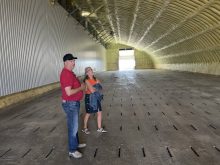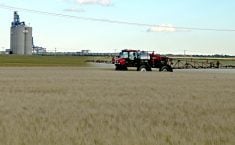HopGuard II, which Health Canada registered in October and is now on the market, was tested and improved in Alberta
Canadian beekeepers have a new weapon against varroa mites.
The treatment, which was tested and improved in Alberta, is now on the market.
“HopGuard II … (was) designed based on new data and developed in Canada,” said Medhat Nasr, former provincial apiculturist with Alberta Agriculture.
“My team worked on that project for about four years to collect all the data … in terms of bee safety, residues in the honey and in terms of efficacy.”
The active ingredient in HopGuard II is the acids found in hops.
Read Also

New coal mine proposal met with old concerns
A smaller version of the previously rejected Grassy Mountain coal mine project in Crowsnest Pass is back on the table, and the Livingstone Landowners Group continues to voice concerns about the environmental risks.
It’s the same hops used to flavour beer.
“Hop beta acids (present as potassium salts) are naturally occurring weak organic acids produced by hop plants,” Health Canada said last year in its registration decision. “HopGuard II consists of strips impregnated with hop beta acids, which are placed in the brood chamber of bee hives by hanging the strips over hive frames.”
Health Canada registered HopGuard II in October.
BetaTec, a firm with offices in Washington State, manufactures and markets the miticide.
It created an earlier version called HopGuard and registered it with the United States Environmental Protection Agency in 2015.
However, HopGuard didn’t perform in Canadian bee hives.
It was supposed to kill 90 to 95 percent of mites but efficacy was less than 50 percent in Canadian conditions, Nasr said.
Alberta Agriculture staff and Nasr conducted research to improve the product. They re-designed the strips that deliver the hop beta acids and increased the dose.
“We were able to get the proper efficacy, 95 percent,” said Nasr, who retired from the province in 2019. He now runs Bee Culture Solutions, a company that provides training for novice and experienced beekeepers.
The introduction of HopGuard II should be helpful for beekeepers, because varroa mites can devastate bee colonies.
“Significant varroa mite infestation in a honeybee colony will cause the loss of the infested colony,” Health Canada says. “Based on the mode of action of HopGuard II, varroa mites are not expected to develop resistance, which is a problem with some other varroa mite control products.”
Canadian beekeepers are highly dependent on one miticide, Apivar, to control varroa mites.
Apiculturists have encouraged beekeepers to use other products to reduce the risk of Apivar resistance.
Nasr said HopGuard II won’t supplant Apivar.
“It’s good because it has a different mechanism to kill the mites,” he said. “But you have to apply two treatments back to back, every 10 to 15 days. That will help to knock down the mites, but it’s going to be a little bit more expensive.”
So, HopGuard II will be part of the solution, but not the only solution.
“Each option has its pros and cons, but they can all work together,” Nasr said. “It goes back to the same concept: integrated pest management.”
One of the benefits of HopGuard II is that it’s a food grade product.
It’s safe for bees, honey and the environment, BetaTec says on its website.
It’s safe for bees, up to a limit, Nasr said.
Beekeepers may be tempted to apply extra to kill every varroa mite.
That’s a mistake.
“If some liquid (is) left in the bag, don’t apply and smear it on the hive,” he said.
“Because that will be over-dosing. Some kill can happen to the bees.”


















